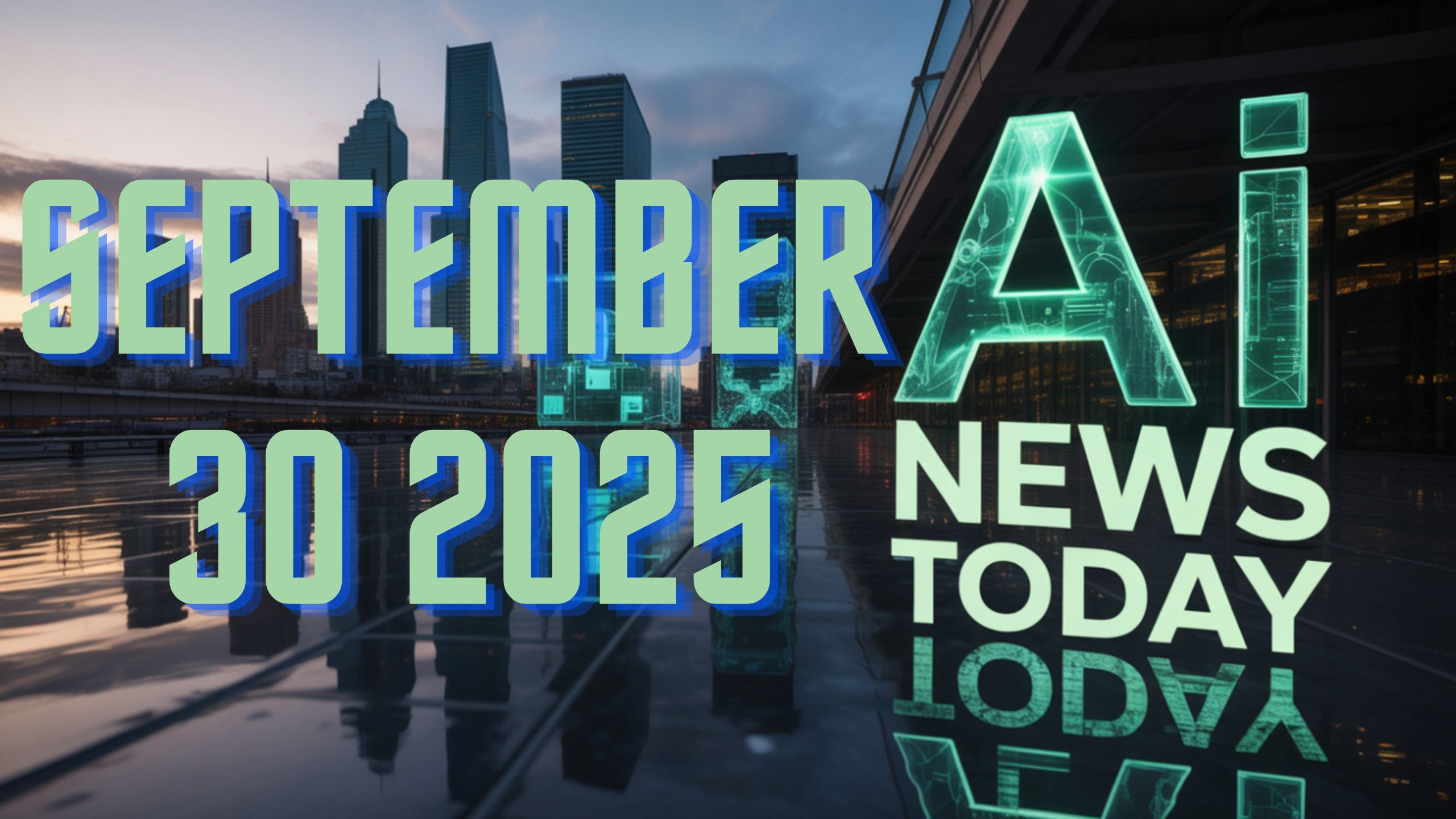AI News Daily — USA (Tuesday, September 30, 2025)– The landscape of artificial intelligence in the United States is undergoing a transformative shift, with September 30, 2025, marking a critical milestone in AI adoption and enterprise integration. From the rise of agentic AI systems—capable of learning, reasoning, and acting independently—to the massive Stargate infrastructure buildout surpassing $400 billion in capital commitments, the pace of innovation is accelerating rapidly. Businesses that adopt these advanced systems early are already experiencing significant gains in revenue and efficiency, while those that lag behind risk falling behind in competitiveness. Alongside infrastructure expansion, initiatives like National AI at Work Day highlight the evolution of the workforce. At the same time, research frameworks, such as MIT’s Net Climate Impact Score, aim to ensure AI’s growth remains sustainable, responsible, and economically impactful.
Agentic AI Powers Widening Value Gap in Enterprises
A groundbreaking industry report reveals that agentic AI—artificial intelligence systems capable of learning, reasoning, and taking autonomous actions—has rapidly evolved from a futuristic concept into a mainstream driver of enterprise growth. These next-generation AI models are now responsible for 17% of total enterprise AI value creation, with projections suggesting that figure will double by 2028.
Early adopters of agentic AI are already experiencing revenue growth twice as fast as their competitors, who lag in adoption. In addition, businesses leading in AI-enabled architectures are unlocking 40% more cost savings, establishing an insurmountable gap between technology leaders and those still experimenting with traditional models.
The US market demonstrates clear momentum, with tech-forward enterprises deploying agent-based AI across various areas, including autonomous customer support, dynamic supply chain optimization, predictive sales targeting, and self-adjusting cybersecurity frameworks. This reflects a significant shift away from mere automation toward decision-centric AI that directly impacts strategic outcomes.
Stargate Infrastructure Buildout Surges Past $400 Billion
The largest AI infrastructure project in the world, known as Stargate, continues to expand at unprecedented scale. Backed by OpenAI, Oracle, and SoftBank, the initiative has already surpassed $400 billion in committed capital, setting ambitious goals to reach 10 gigawatts of US data center capacity by the end of 2025.
The financing strategy for Stargate blends debt funding, chip vendor partnerships, and asset-backed deals, creating a unique wave of vendor-financed expansion. Analysts caution that while the capital influx accelerates deployment, the long-term profitability risks may grow if monetization models fail to keep pace with enormous capital expenditures.
Five new regional hubs are already progressing through local permitting and power agreements, and construction sites are expected to employ tens of thousands of American workers. Beyond pure infrastructure, Stargate is also driving innovation in energy sourcing, with efforts aimed at integrating renewable energy into large-scale AI clusters for greater sustainability.
National AI at Work Day: Shaping the Future of Work
September 30 has now been recognized as National AI at Work Day, highlighting the profound impact of artificial intelligence on the modern workplace. Across the United States, employers are celebrating the day by offering AI upskilling challenges, free training demos, and hands-on workshops for employees.
The emphasis lies on developing agentic workflows, where employees and AI systems collaborate seamlessly. US businesses are increasingly viewing AI fluency as a critical skill set—not only for data scientists, but also for sales teams, HR departments, marketing strategists, and operations leaders.
Clodura.AI has contributed to this momentum by releasing a unified sales and go-to-market platform upgrade, powered by generative AI tools. The platform aims to streamline enterprise adoption by reducing workflow redundancies and enabling more adaptive, performance-linked execution. This movement toward AI-first work cultures is becoming a defining factor in enterprise competitiveness.
Research and Sustainability: The Net Climate Impact Score
As AI adoption accelerates, so do concerns about its environmental footprint. This week, MIT researchers introduced the Net Climate Impact Score (NCIS), a comprehensive framework designed to measure the carbon implications of AI systems.
The NCIS establishes parameters for evaluating AI models across training energy consumption, deployment efficiency, and offset mechanisms, creating an actionable blueprint for both corporate and regulatory adoption. The initiative emphasizes the importance of collaborative standards among business leaders, academic institutions, and government agencies to mitigate the environmental impact of AI.
With compute-heavy projects like Stargate expanding rapidly, frameworks like the NCIS may soon become essential for aligning sustainability targets with technological innovation. The report suggests that widespread implementation could reduce AI’s resource intensity by 40% over the next decade.
AI in Healthcare: Driving Next-Generation Discovery Pipelines
US pharmaceutical and biotech companies are undertaking a radical transformation of their research and development pipelines through the integration of AI. Drug manufacturers are pursuing end-to-end AI adoption, where generative and agentic AI systems interact directly with lab hardware, robotics, and gene sequencing technologies.
This represents a shift from model-assisted discovery to autonomous experimental design, where AI not only proposes new compounds but also conducts simulations, lab tests, and refines results in real-time. Industry leaders anticipate that such systems could cut drug discovery timelines by up to 60%, unlocking faster responses to emerging diseases and reducing development costs.
AI-driven automation is also being applied to personalized medicine, with models predicting patient-specific drug interactions, gene therapy outcomes, and dosage responses. The implications extend far beyond pharmaceuticals, shaping the future of genomics, precision healthcare, and biotech research in the United States.
Financing Risks and Enterprise Strategies in AI Expansion
While the US AI ecosystem accelerates with investment and innovation, financing risks are becoming a critical consideration. Vendor-financed infrastructure projects may lead to margin compression if AI monetization does not keep pace with the growth of these projects. Experts caution that companies should strike a balance between short-term capital inflows and sustainable revenue models, particularly as cloud service pricing, licensing, and AI-driven products evolve rapidly.
Enterprises that combine agentic AI strategies, sustainable financing, and workforce AI literacy are positioned to gain the most. Businesses that fail to keep pace risk being trapped in high-cost, low-return AI deployments, while leaders stand to capture exponential growth in both productivity and profitability.
The Broader Picture: AI as a National Growth Engine
Taken together, these developments underscore the multi-dimensional role of AI in the US economy. From enterprise competitiveness and mega-infrastructure projects to workforce transformation and sustainable research, the trajectory of AI is defining a new industrial revolution.
By 2030, analysts predict that AI-driven enterprises could account for more than one-third of total US GDP growth, fueled by breakthroughs in agentic systems, resilient data infrastructure, and cross-sector innovation. The challenge now lies in ensuring that these advances remain profitable, sustainable, and equitable, balancing technological progress with environmental stewardship and workforce readiness.
AITeam is the dedicated editorial team of Android Infotech, consisting of experts and enthusiasts specialized in Android-related topics, including app development, software updates, and the latest tech trends. With a passion for technology and years of experience, our team aims to provide accurate, insightful, and up-to-date information to help developers, tech enthusiasts, and readers stay ahead in the Android ecosystem.
For more about our team, visit our About Us page.




Leave a Reply